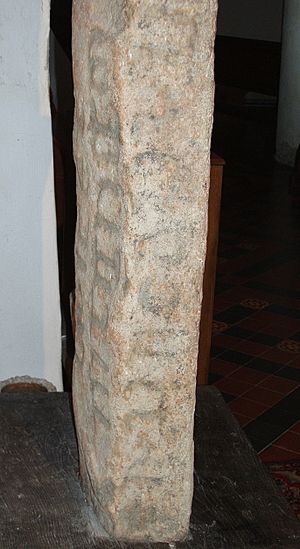Cadfan Stone facts for kids
The Cadfan Stone (also called the Tywyn Stone) is a special stone cross found inside St Cadfan's Church in Tywyn, Gwynedd, Wales. It's famous because it has the oldest known writing in the Welsh language. This writing is in a very old form of Welsh called Old Welsh.
Contents
The Amazing Cadfan Stone
The Cadfan Stone is a tall stone monument with carvings and writing on it. It's like a historical message from a long, long time ago! It helps us understand how the Welsh language looked and sounded many centuries ago.
How Old Is This Stone?
Experts have studied the Cadfan Stone for many years to figure out exactly how old its writing is. Most recent studies suggest the writing was made in the 9th century (the 800s). However, some scholars used to think it was even older, perhaps from the 7th century (the 600s) or 8th century (the 700s). So, while the exact date is still debated, everyone agrees it's incredibly ancient, dating back somewhere between the 7th and 9th centuries.
What Does the Stone Look Like?
When it was first made, the Cadfan Stone was very tall, over 2.3 meters (that's more than 7.5 feet!). Today, it's still quite tall, measuring about 2.18 meters (around 7 feet 2 inches). It's also about 25 centimeters (10 inches) wide and 20 centimeters (8 inches) thick. Imagine a stone taller than most adults, covered in ancient writing!
What Does the Writing Say?
The writing on the Cadfan Stone is very old and can be hard to read, even for experts. But scholars have worked hard to understand what it means. The inscriptions seem to be about people and their burials. Here are some of the ideas about what the different parts of the stone say:
- One part might say something like: "Tengrumui, the married wife of Adgan, lies close to Bud and Marciau."
- Another section mentions "the mortal remains of the three," suggesting it's about three people who have passed away.
- A different part might say: "Cun, the wife of Celyn, a deadly wound remains."
- And another section refers to "the mortal remains of four."
These inscriptions give us a glimpse into the lives and deaths of people who lived in Wales over a thousand years ago.
Why Is the Cadfan Stone Important?
The Cadfan Stone is super important because it has the earliest known examples of the Welsh language written down. This helps historians and language experts understand how Welsh developed over time. It's like finding the very first notes of a song that's still sung today!
Even though it's so important, not many Welsh writers or poets have written about the Cadfan Stone. However, some have, like Owain Owain with his poem 'Cofebion Tywyn' and Myrddin ap Dafydd with 'Y boen'. These poems help share the story of this amazing historical treasure.


